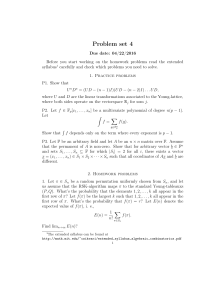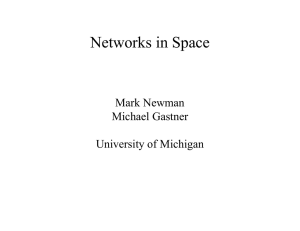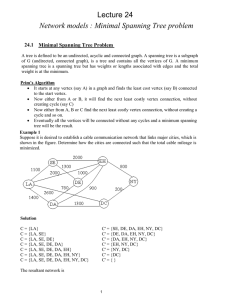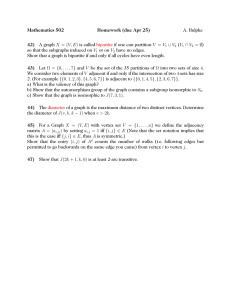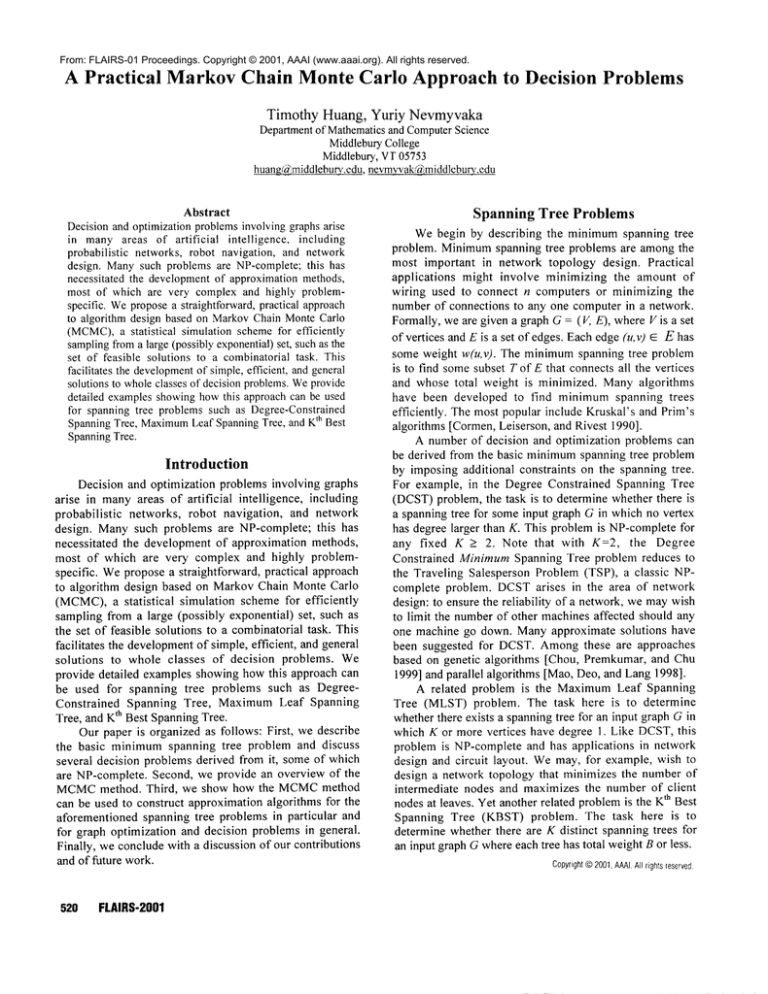
From: FLAIRS-01 Proceedings. Copyright © 2001, AAAI (www.aaai.org). All rights reserved.
A Practical
MarkovChain Monte Carlo Approach to Decision Problems
Timothy Huang, Yuriy Nevmyvaka
Departmentof Mathematicsand ComputerScience
MiddleburyCollege
Middlebury,VI" 05753
huang(~)~mid
dlebu ry.edu, nevmyvak@middleburs,.edu
Abstract
Decisionand optimizationproblemsinvolving graphs arise
in manyareas of artificial intelligence, including
probabilistic networks, robot navigation, and network
design. Manysuch problems are NP-complete;this has
necessitated the developmentof approximationmethods,
most of which are very complex and highly problemspecific. Weproposea straightforward, practical approach
to algorithm design based on MarkovChainMonteCarlo
(MCMC),
a statistical simulation schemefor efficiently
samplingfroma large (possiblyexponential)set, suchas the
set of feasible solutions to a combinatorial task. This
facilitates the development
of simple,efficient, andgeneral
solutions to wholeclasses of decision problems.Weprovide
detailed examplesshowinghowthis approachcan be used
for spanning tree problems such as Degree-Constrained
SpanningTree, Maximum
Leaf SpanningTree, and Kth Best
SpanningTree.
Introduction
Decision and optimization problems involving graphs
arise in manyareas of artificial intelligence, including
probabilistic networks, robot navigation, and network
design. Many such problems are NP-complete; this has
necessitated the development of approximation methods,
most of which are very complex and highly problemspecific. Wepropose a straightforward, practical approach
to algorithm design based on Markov Chain Monte Carlo
(MCMC),
a statistical simulation scheme for efficiently
sampling from a large (possibly exponential) set, such
the set of feasible solutions to a combinatorial task. This
facilitates the developmentof simple, efficient, and general
solutions to whole classes of decision problems. We
provide detailed examples showing howthis approach can
be used for spanning tree problems such as DegreeConstrained Spanning Tree, MaximumLeaf Spanning
Tree, and Kth Best SpanningTree.
Our paper is organized as follows: First, we describe
the basic minimumspanning tree problem and discuss
several decision problems derived from it, some of which
are NP-complete. Second, we provide an overview of the
MCMC
method. Third, we show how the MCMC
method
can be used to construct approximation algorithms for the
aforementioned spanning tree problems in particular and
for graph optimization and decision problems in general.
Finally, we conclude with a discussion of our contributions
and of future work.
520
FLAIRS-2001
Spanning Tree Problems
Webegin by describing the minimumspanning tree
problem. Minimumspanning tree problems are amongthe
most important in network topology design. Practical
applications might involve minimizing the amount of
wiring used to connect n computers or minimizing the
number of connections to any one computer in a network.
Formally, we are given a graph G = (V, E), whereV is a set
of vertices and E is a set of edges. Eachedge (u,v) E has
some weight w(u,v). The minimumspanning tree problem
is to find somesubset T of E that connects all the vertices
and whose total weight is minimized. Manyalgorithms
have been developed to find minimumspanning trees
efficiently. The most popular include Kruskal’s and Prim’s
algorithms [Cormen,Leiserson, and Rivest 1990].
A number of decision and optimization problems can
be derived from the basic minimumspanning tree problem
by imposing additional constraints on the spanning tree.
For example, in the Degree Constrained Spanning Tree
(DCST)problem, the task is to determine whether there
a spanning tree for someinput graph G in which no vertex
has degree larger than K. This problem is NP-completefor
any fixed K _> 2. Note that with K=2, the Degree
Constrained MinimumSpanning Tree problem reduces to
the Traveling Salesperson Problem (TSP), a classic NPcomplete problem. DCSTarises in the area of network
design: to ensure the reliability of a network, we maywish
to limit the numberof other machinesaffected should any
one machine go down. Manyapproximate solutions have
been suggested for DCST. Amongthese are approaches
based on genetic algorithms [Chou, Premkumar, and Chu
1999] and parallel algorithms [Mao, Deo, and Lang1998].
A related problem is the MaximumLeaf Spanning
Tree (MLST) problem. The task here is to determine
whetherthere exists a spanningtree for an input graph G in
which K or more vertices have degree 1. Like DCST,this
problem is NP-completeand has applications in network
design and circuit layout. Wemay, for example, wish to
design a network topology that minimizes the number of
intermediate nodes and maximizes the number of client
nodes at leaves. Yet another related problemis the Kth Best
Spanning Tree (KBST) problem. The task here is
determine whether there are K distinct spanning trees for
an input graphG whereeach tree has total weightB or less.
Copyright
©2001,AAAI.All rights reserved.
Markov Chain Monte Carlo
Followingthe treatment in [Jerrum and Sinclair 1996],
we provide an overview of the MarkovChain Monte Carlo
(MCMC)method. The MCMC
method makes it possible
to efficiently sample from a large combinatorial set
according to a desired probability distribution and can be
used for function optimization.
Supposethat ~Qis a large, finite combinatorial set and
that f: £2 --> R+ is a function defined on .(2. Wemaywish
to find a solution x E £2 such that f(x) is maximal. The
MCMC
method requires that we define an undirected,
connected graph Won all possible solutions to the problem
and a set of one or more moves, i.e., relatively simple
operations that transform one element of £2 to another.
Each vertex of Wrepresents a memberof ,(2, i.e., one
possible solution, and each edge represents a move.Wis
called a neighborhood structure because the neighbor
vertices of any vertex x correspond to the set of solutions
reachable via a single movefrom the solution represented
by x.
Howa neighborhood structure is defined depends on
the particular problem. For example, to find the maximum
cut of a graph G, we might define Wsuch that each vertex
represents a partition of G into two subgraphs. The edges
of any vertex in W would connect to vertices
corresponding to partitions that could be obtained by
moving an element in G from one subgraph to the other.
By contrast, to find the maximum
numberof matchings in
an undirected graph G, we might define Wsuch that each
vertex denotes a set of matchings in G, and each edge
connects a set to another set obtained by removing,adding,
or replacing a single matching.
By representing each vertex of Wwith a set of features
and each edge as a change to one feature, we can simulate
a Markovchain through the space of possible solutions. In
particular, we represent each vertex X e Was a vector ofk
randomvariables, i.e., X= { Xl ..... X, ..... Xk},wherek is
the numberof parameters needed to describe elements in
G. An edge between X and another vertex X’ = {X1.....
X’i ..... Xk}indicates that X and X’ differ by one parameter
value Xi (1 < i < k). A randomwalk on the vertices of
thus represents a sequence of solutions in which each
solution differs from the previous solution by at most one
feature (solutions can repeat). This sequence is a Markov
chain because at each step in the sequence, the choice of
the next solution dependsonly on the current solution and
not on any previous ones.
In short, the MCMC
approach to optimization and
decision problems involves simulating the Markovchain
for some numberof steps T, beginning with an arbitrary
initial solution, and then either outputting the best solution
seen so far or outputting whether a solution has been
found. Due to the Markovproperty, any algorithm based
on generating a randomizedsequence of solutions doesn’t
need to maintain a data structure for the entire graph W.In
most cases, this wouldbe impossible, given the large size
of£2.
Weintroduce bias into the random walk so that it
favors better solutions. This usually means always
accepting transitions of the Markovchain to states with
higher fvalue but occasionally accepting transitions to
states with lower f value. In particular, supposedegree(x)
denotes the degree of vertex x in W, and suppose D(W)
denotes an upper bound on the maximumdegree. The
transition from a current vertex x to the next vertex is
specified as follows:
I. with probability 0.5 lety = x; otherwise,
Ii. selecty accordingto the distribution:
ify is a neighborof x;
[" 1/D(W)
Pr(y) = ~ lo - degree(x)/D(W) ify= x;
otherwise
lII. withprobabilitymin{1,asCv)s(x)}, transition to
otherwise,stay at x, i.e., repeat the state
represented by x.
Note that ~ > 1; this ensures that transitions to neighbors
with higher f values are always accepted and that
transitions to neighbors with lowerfvalue are rejected with
probability (1 - c~so’)-s/x)) < 1. The last inequality holds
since f(y) - f(x) < 0 whenthe state denoted by y is a less
desirable state; thus, 0 < ascv~(x)< 1 and (1 - s~(X))< 1.
To showthat the resulting Markovchain converges to a
stationary distribution, we note the following properties:
First, since Wis connected by definition, the Markovchain
is irreducible, i.e., any state can eventually be reachedfrom
any other state. Second,since all self-loop probabilities are
required to be non-zero, the chain is aperiodic and hence
ergodic, i.e., there are no fixed cycles throughwhichstates
will alternate. Theprobability distribution of this chain can
then be defined as
rc~ = o~s(x)/z(cO, for all x c £2,
(1)
whereZ(c~) is a normalizing constant that ensures n~ is
probability distribution. Finally, we note that the chain is
also reversible, i.e., it satisfies the detailed balance
condition:
~=(x)P(x, y) =r~Jy) PO~,for all x, y~ £2.
These conditions guarantee that the Markov chain
converges to the stationary distribution n=. Detailed
definitions of each requirement and proofs of convergence
can be found in [Tierney 1996] and [Taylor and Karlin
1984]. A Markov chain of this form is known as a
Metropolisprocess [Metropolis, et.al. 1953].
The parameter c~ influences the rate at which the
algorithm finds better solutions and the ability of the
algorithm to movebeyond local maximain the solution
space. Lower values of ~ smooth out the distribution n~
and help keep the chain from getting stuck in local
maxima;higher values of ~ makethe distribution n~ more
peaked around optimal solutions and help find better
OPTIMIZATION 521
solutions more quickly. At the two extremes, we have an
unbiased random walk on the graph Wwhen ¢x = 1 and a
greedy search when ~ = oo. Hence, some intermediate
value for ¢x is usually preferred. Jerrum and Sinclair
provide a detailed analysis of the Metropolis algorithm at
a in [Jerrum and Sinclair 1996]. Varying o~ while the
process is simulated results in a simulated annealing
algorithm [Kirkpatrick, Gelatt, and Vecchi1983].
MCMCApplied to Spanning Tree Problems
Having discussed minimumspanning tree problems and
the MCMC
method, we now show how the method can be
applied in a general, straightforward way to developing
approximation algorithms for a whole class of decision
problems. In manysituations, this maybe more practical
than using a complex, specialized solution that doesn’t
adapt readily to related problems. As an example, we show
how the same neighborhood structure can be used for
DCST,MLST,and KBST.Only the heuristic evaluation
function and the ~x parameterare different in each problem.
Selecting a neighborhood structure
The first step in applying MCMC
to a minimum
spanning tree problem on some input graph G is defining
an appropriate graph representation Wof the space .(2. It
would be problematic to restrict this to the set of all
possible solutions, i.e., to the set of all spanningtrees. The
difficulty lies in finding simple movesthat transform one
spanning tree to another. Withoutthese, we aren’t able to
define a suitable neighborhood structure
for W.
Furthermore,finding an arbitrary initial solution in a space
of spanningtrees maybe nontrivial for complexgraphs.
To address these concerns, we define .Q to include all
possible subgraphs of a graph G that are connected trees.
Vertices in Wrepresent subgraphs of G, and edges in W
connect vertices corresponding to subgraphs that differ by
one additional or one fewer edge. This allows us to define
a connected neighborhood structure that includes all
spanningtrees of the graph G. Choosingan initial state for
the Markovchain becomes trivial; it can be any single
vertex from the input graph G. From this vertex, we can
grow a solution for any minimumspanning tree problem
by incrementally adding additional edges.
Withmodifications to the set of vertices and the set of
allowable edges, the graph representation
Wcan be
adapted to describe the neighborhood structure for many
other graph decision and optimization tasks, not only
spanning tree problems. Once the graph Wis defined, it
can be applied to manyproblems in that class by using
different maximization functions and ~ parameters. We
provide examples of this process in our solutions to the
MLSTand KBSTproblems.
522
FLAIRS-20Ol
Degree Constrained Spanning Tree
We now describe how we applied the MCMC
method
to DCST,wherethe task is to determine whether there is a
spanning tree for input graph G in which no vertex has
degree larger than some value K. Wewill address the
following tasks: constructing the Markovchain, designing
an evaluation function, and choosing an appropriate value
for the c~ parameter.
Our algorithm and edge update rules adapt the model
of [Jerrum and Sinclair 1996] to degree constrained
spanning trees. Here, E denotes the set of edges in Wand
each instance of randomOdenotes a new random number
between0 and 1.
Step 1. Define neighborhood.Chooseinitial state x ~ W.
Step 2. lfrandomO< 0.5, stay atx; else,
IfrandomO
<(l-(degree(x))/([EI)), stay at x; else
Randomlychoose a neighbor y.
If the f(y) >f(x),
moveto y.
Else ifrandomO< min{1,o~f~v)-s(x)}, moveto
Else stay at x.
Step3.: Repeatstep 2 for somenumberof steps T or until
a state corresponding to a minimum
spanning tree
of degree K or less is found.
Step 4. If tree found, output yes; else output don’t know.
The initial state of the Markovchain is a vertex in W
corresponding to a randomvertex of the input graph G. Its
neighbors in Wrepresent subgraphs of G that consist of a
single edge in G, one vertex of whichis the initial vertex.
At each step in the chain, the subgraph represented by the
current vertex transitions to another subgraph made by
adding an edge to or deleting an edge from the current
subgraph, subject to the constraint that the graph remains a
connectedtree.
Recomputing the neighborhood of a vertex at each
transition is inefficient. Instead, we maintain a list L of
edges that can be added to the current subgraph, and we
update the list at each transition. The following rules
summarizehowL is updated whenan edge (vl, v2) is added
to the subgraph (where vl already belongs to the subgraph
and v: is a new vertex) or when edge (vl, v:) is deleted
from the subgraph (where v~ remains part of the subgraph
but v: does not):
After adding a new edge (vl, v2): Addto L those
edges in G the have one vertex v2 and the other vertex
not in the current subgraph. Removefrom L those
edges that have one vertex v2 and the other in the
current subgraph (to prevent cycle creation). Remove
from L those edges that have one vertex v~ and the
other vertex belonging to another edge in the subgraph
(to prevent splitting the subgraphin two)
After removing an edge (’Pl,
~2)" Add to L those
edges of G that have one vertex vl and the other vertex
not in the current subgraph. Addto L those edges with
one vertex v2 and the other vertex belonging to the
current subgraph (these edges would have created
loops before). Removefrom L those edges with one
vertex v2 and the other vertex not in the current
subgraph(these edges are no longer reachable).
Wenow propose a heuristic evaluation function to
direct the Markovchain toward solution states. The aim is
to favor subgraphs with as manyedges as possible but with
no vertices having degree greater than K. Supposethat the
Markovchain algorithm proposes adding an edge so that
the resulting subgraph has a maximum
vertex degree of M.
If this subgraph has increased maximum
vertex degree and
Mr>K, we discourage the transition by accepting it with
probability txTM. The greater the difference betweenMand
K, the less likely we are to accept the transition. If M<K,
we alwaysaccept the transition since it brings the subgraph
closer to a spanning tree. If the algorithm proposes
removingan edge, we accept the transition with probability
c(v(ll’!), where IEI is the numberof edges in the current
subgraph. The greater the percentage by which the
subgraph size is reduced, the less likely we are to accept
the transition. In this way, we discourage transitions away
from a spanning tree. The only time we prefer a reduction
to the size of the tree is whenit decreases the maximum
degree of a tree whose maximumdegree already exceeds
K; in those cases, we always accept the transition. We
believe this evaluation function is intuitively compelling,
and preliminary experimental results have shownit to work
efficiently in practice.
Wenowaddress the task of choosing a parameter c~.
For someproblems, a higher value works fine, whereas for
other problems it leads to difficulties. The Markovchain
generated by our algorithm starts from a single vertex and
incrementally adds vertices on most transitions. Even when
it needs to remove edges in order to make additional
progress toward a spanning tree, it rarely needs to
backtrack manysteps in sequence. Hence, in practice the
value of c~ can be set quite high without muchdanger of
the chain getting trapped in local maxima.Nevertheless,
performance begins to deteriorate once c~ surpasses a
certain threshold, reducing the algorithm to greedy search.
Choosingc¢ remains something of a black art. [Jerrum
and Sinclair 1996] describe sometechniques for doing so,
though to this day there are few rigorous results. In
general, we wish to minimizehitting time, the time it takes
to reach one state whenstarting from another. Preliminary
results with our evaluation function and c~ parameter
suggest that the hitting time of our Markovchain algorithm
grows in polynomial time with the size of the input graph
G, though this requires further investigation. [Jerrum and
Sinclair 1996] and [Sinclair 1992] discuss hitting time and
convergencein substantial detail.
Related Spanning Tree Problems
A key benefit
of the MCMC
approach is that
algorithms for related problems can be devised using the
same neighborhood structure.
For example, we now
propose an algorithm to solve the MLSTproblem that uses
the same neighborhood structure as DCSTbut has its own
evaluation function and other considerations for choosing
o~. In MLST,
the task is to determinewhetherthere exists a
spanning tree for an input graph G in which K or more
vertices havedegree 1.
Weuse an algorithm nearly identical to the one
proposed for DCST.Generally, the algorithm encourages
the addition of new edges and discourages the removal of
existing edges. With MLST,however, we wish to find
trees with K or more leaves. Thus, we modify our
algorithm so that whenit suggests transitions to subgraphs
with K or moreleaves, we imposeno additional restrictions
on adding or removingedges. Whenit suggests transitions
to subgraphs with fewer than K leaves, however, we reject
such transitions in proportion to the difference betweenthe
resulting number of leaves and K. The rules governing
edges that can be added or removedremain the same.
In some ways, MLSTis the opposite of DCST,and
this influences our choice of evaluation function and of cx.
Whereasthe DCSTalgorithm has little trouble keeping the
maximumdegree of any vertex below K while searching
for a spanning tree, the MLSTalgorithm must constantly
trade off between trying to increase the size of the
subgraph and keeping the number of leaves above K.
Backtracking several steps in sequence occurs muchmore
frequently
with the MLSTalgorithm.
Hence, our
evaluation function places greater weight on tree growth
when the subgraph is small and greater weight on
maintaining the number of leaves as the subgraph gets
larger. To provide the chain enough mobility to
accommodate
the two conflicting goals, we use a relatively
small value for c~. As with DCST,we can’t allow the value
of o~ to becometoo small, since the Markovchain becomes
a randomwalk as c~ approaches1.
Like MLST,an approximation algorithm for solving
KBSTcan be developed using the original neighborhood
structure. Since the task is to determine whetherthere are
K distinct spanningtrees for input graph G, each with total
weight B or less, there are nowthree possibly conflicting
goals: growingthe size of the tree, keeping the weight of
the tree below B, and finding trees different from the ones
already discovered. Again, we can reuse the neighborhood
structure
and basic algorithm. As with MLST, our
evaluation function weights the signficance of each goal
dependingon the developmentof the subgraph. It also uses
an even smaller value of c~ to encourageexploration. While
experimental results are not the focus of this paper, we
OPTIMIZATION 523
have implementedalgorithms for all three spanning tree
problems, and preliminary results for convergence have
been promising.
Generalizing the Approach
Having discussed how MCMC
can be applied to three
different but related spanning tree decision problems, we
nowconsider the general principles involved in developing
solutions to decision and optimization problems.
First, we must define a set of all feasible solutions to
the problem, along with the features that characterize
optimal solutions. Furthermore, we must identify simple
operations that transform one candidate solution to another.
It’s important that every solution to be reachable from any
other solution and appear exactly once in the set.
Otherwise, someoptimal solutions maybe left out or some
states mayreceive undue preference.
Next, we must engineer a Markovchain that performs
a biased randomwalk on the search space and that satisfies
previously defined convergence conditions. So that the
chain will favor more desirable states over less desirable
ones, we define a heuristic evaluation function on states.
This function should capture the essence of optimal
solutions, assigning higher values to states closer to them.
If somecases, the evaluation function will need to weigh
the tradeoffs betweenconflicting optimizingcriteria.
The choice of the o~ parameter dependsheavily on the
specific problem. As a rule of thumb, ~ should be small
when the Markov chain requires substantial mobility
throughout the solution space but can be large when the
chain performs little backtracking. Usually, c~ must be
refined experimentally.
Conclusions
and Future Work
The primary goal of this paper has been to show how
the MarkovChain Monte Carlo method can be applied to
solving whole classes of decision problems. Wehave
demonstrated this by describing in detail how the same
basic approach can produce approximation algorithms for
three different spanning tree problems: DegreeConstrained
Spanning Tree, MaximumLeaf Spanning Tree, and th
K
Best Spanning Tree. Each solution uses the same
neighborhoodstructure and basic Markovchain algorithm.
Theydiffer only in their evaluation functions and selection
of ~ parameter. Thus, MCMC
provides a practical
alternative to developing and using complex, ad hoc
solutions to closely related problems.
A second contribution is the adaptation of Jerrum and
Sinclair’s basic Markov chain algorithm to decision
problems involving spanning trees. Weprovide rules
explaining howthe sequence of subgraphs in the chain can
be generated without recomputing the neighbors of each
vertex after every transition.
A third contribution
is the specification
and
description of heuristic evaluation functions and the o~
524
FLAIRS-2001
parameter for driving the evolution of the Markovchain
for each problem, particularly DCST.
Wehave implemented algorithms for DCST, MLST,
and KBST, and they have produced promising
experimental results. Weare currently comparing how
these approximationalgorithms perform in practice against
other types of approximation algorithms for the same
problems.
Finally, there remains much room for stronger
theoretical results. Weare workingto develop techniques
for finding mathematicalbounds for the convergencerates
of our algorithms and for determiningoptimal values of the
parameter ~.
Acknowledgements. This work was supported by
Middlebury College and by the National Science
Foundation (NSF)under grant #9876181.
References
Chou H., Premkumar G., and Chu C.-H. 1999. "Genetic
Algorithms and Network Design: An Analysis Of Factors
Influencing Network Performance." EBusiness Research
Center Working Paper.
Cormen, T.H., Leiserson, C.E., and Rivest, R.L. 1990.
Introduction to Algorithms. Cambridge,MA:MITPress.
Jerrum, M.R. and Sinclair, A.J., 1996. "The MarkovChain
Monte Carlo Method: An Approach to Approximate
Counting and Integration," In Approximation Algorithms
for NP-HardProblems, HochbaumD.S., ed. Brooks/Cole.
Kirkpatrick, S., Gelatt, C.D., and Vecchi, M.P. 1983.
"Optimization by Simulated Annealing." Science,
220:671-680.
Mao, L.-J., Deo, N., and Lang, S.-D. 1998. "A Parallel
Algorithm for the Degree-Constrained MinimumSpanning
Tree Problem Using Nearest Neighbor Chains." In
Proceedings of the Fourth International Symposium on
Parallel Architectures, Algorithms, and Networks.
Metropolis, N., Rosenbluth, A.W., Rosenbluth, M.N.,
Teller, A.H., and Teller, E. 1953. "Equation of State
Calculation by Fast ComputingMachines." In Journal of
Chemical Physics, 21:1087-1092.
Sinclair A. 1992. "Improved Bounds for Mixing Rates of
Markov Chains and Multicommodity
Flow." In
Combinatorics, Probability and Computing,1:351-370.
Taylor, H.M., and Karlin, S. 1984. An Introduction to
Stochastic Modeling. Orlando, FL: AcademicPress.
Tierney, L. 1996. "Introduction to General State-Space
Markov Chain Theory." In Markov Chain Monte Carlo in
Practice. Gilks W.R., Richardson S., and Spiegelhalter
D.J., eds. Boca Raton, FL: Chapman&Hall.



